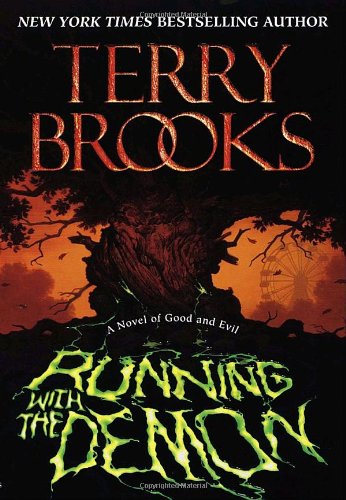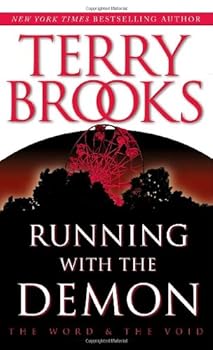
 Running With the Demon by Terry Brooks
Running With the Demon by Terry Brooks
Did You Sell Your Soul for So Little?
Terry Brooks is best known for his Shannara series, which is immensely popular despite being rather obviously inspired by Tolkien’s plots, characters and themes. For reasons even I can’t explain, I’ve read quite a few of these novels (despite my disdain for them) and so I can say with a fair amount of confidence that Running With the Demon is undoubtedly Brooks’s best novel. Moving away from his fantasy subworld of dwarfs, elves, magical talismans and plucky young farmboys-cum-heroes, the only thing Brooks hangs on to is his good against evil theme, placing it in contemporary America.
Here good and evil are represented by the Word and the Void; the former benevolent and creative, and the latter destructive. The exact relationship of these two sides is only briefly touched on and as such never explored in any great detail; instead Brooks chooses to focus on one skirmish that both sides are deeply invested in: the fate of a young girl and the events that unfold over a four-day period in a small town called Hopewell, Illinois. Two representatives of the warring sides come here in the days leading up to the fourth of July; a demon who has returned in order to see a long-laid plan come to fruition, and John Ross, a Knight of the Word whose mission is to stop him. As a Knight, Ross spends his nights dreaming of the apocalyptic future that is in store for the world, roaming the wastelands and collecting information and clues of what has transpired in order for him to act in the present to prevent such horrors from ever occurring. At the center of both their quests is a fourteen-year old girl named Nest Freemark.
 Nest is a girl living a double life. On the one hand, she enjoys loving grandparents, a close knit group of friends, a comfortable home adjacent to sprawling parklands and a promising future in athletic competition. But on the other, she sees shadowy figures known as feeders who feast on human emotion, is best friends with a sylvan named Pick who acts as guardian to the park, and has internal magical gifts at her disposal. This situation is tricky enough, but she is often haunted by the fact her mother committed suicide when she was just a baby and the mystery of her completely unknown father; and her Gran (her one human confidant of the world of magic) is close-lipped about both subjects.
Nest is a girl living a double life. On the one hand, she enjoys loving grandparents, a close knit group of friends, a comfortable home adjacent to sprawling parklands and a promising future in athletic competition. But on the other, she sees shadowy figures known as feeders who feast on human emotion, is best friends with a sylvan named Pick who acts as guardian to the park, and has internal magical gifts at her disposal. This situation is tricky enough, but she is often haunted by the fact her mother committed suicide when she was just a baby and the mystery of her completely unknown father; and her Gran (her one human confidant of the world of magic) is close-lipped about both subjects.
Brooks creates a carefully plotted thriller/fantasy that combines… well everything. A gruesome monster gradually breaking out of its tree-prison, feeders luring innocent children into danger, a love-interest that is under threat from a more mundane human-evil, a school bully who holds resentment toward Nest, a ghostly dog-wolf whose origins are a mystery, a steelworks strike that is eroding the well-being of the town and causing some to plot drastic action and a dark family secret are all intertwined wonderfully to create a sustained, exciting, poignant story, that ultimately culminates in a darn good read. Every single plot thread, down to a lost kitten, is wrapped up satisfactorily.
There is only one crucial misstep, and that is when the demon is shown as having enough power to instantaneously kill a human being with a simple gesture. By doing so, Brooks infuses the demon with too much power, making later parts of his plan illogical when he stages various ways to rid himself of enemies that involve more elaborate schemes. If he has that much power over life and death, why doesn’t he simply eliminate everyone in his way? With this one exception, the story is tightly structured, with the agendas, motivations and goals of both Ross and the demon well-paced and understandable — and with a final twist that’s immensely satisfying.
Whereas most of the characters in the Shannara series are standard sword-and-sorcery stereotypes (the wise druid, the mystical elf, the winsome love-interest, the gruff dwarf), Brooks presents here a range of three-dimensional characters who interact with each other realistically. Everyone is given a useful part to play within the context of the story and no one bond is given precedence over any other, whether it be the rocky marriage of Nest’s grandparents, the tentative bond that forms between John and Nest, the secret but unified force of Nest and Pick, or the warm and bickering nature of Nest’s friends Robert, Cass, Brianna and Jared. Everyone acts in the way one would expect from their character, and all come across as sympathetic, likeable, solid characters — ones that you’d like to meet in real life. Nest in particular shines as the confused, conflicted but ultimately brave young heroine, but other standouts are the grouchy Pick and his owl, Nest’s befuddled grandfather Old Bob, her no-nonsense grandmother Evelyn, and her loudmouth friend Robert who comes closer than he realizes in discovering the truth about Nest.
Running With the Demon was followed by two sequels which paled in comparison to the workmanship and characterisation of the first book. Reading this book left me uplifted and thoughtful, the others left me depressed and dissatisfied thanks to sloppy storytelling and the removal of many favourite characters introduced here. My advice is to read Running With the Demon as a stand-alone novel, as the sequels really aren’t worth the effort.






I've thought about picking that one up. The artwork looks perfect.
I like the way you think, Bill. I found the second one particularly objectionable; the one with Khan. It was…
I find if I take every Trek reference out of them (the title, the character names, the ship names, etc.),…
I loved this deep dive into Edwige Fenech's Giallo films! Her performances add such a unique flavor to the genre.…
It would give me very great pleasure to personally destroy every single copy of those first two J. J. Abrams…